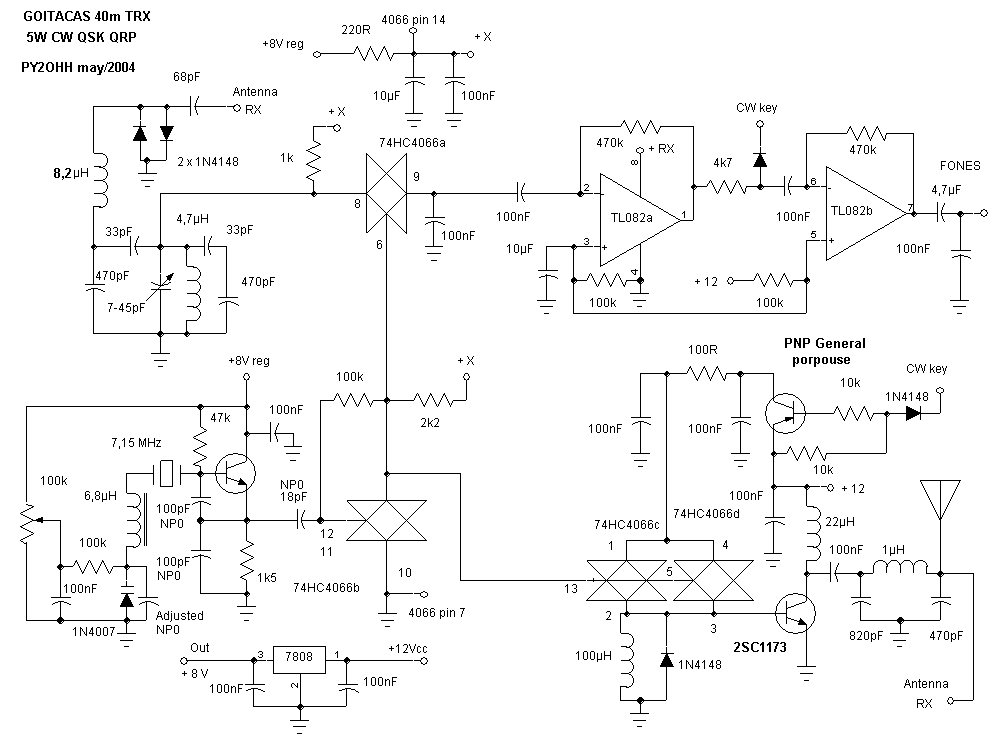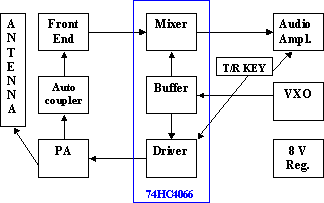GOITACAS
TRX 40m - Rx DC - Tx 5W - VXO 6990 -7080kHz
I still studying some RF application of 74HC4066 IC, I decided to made a
transceiver with a little more power 5W.
In the last project with the 74HC4066, it it was acting as to mixer, buffer,
oscillator VXO and driver in the Tx. In order to increase the power, I decide
to substitute the VXO who uses na analogic gate of the 74HC4066, for a VXO using
a BJT transistor. Now the two remaining analogics gates are in parallel circuit.
Practically whole this project is the same of the CAIAPO project, the main
alteration was really in the excitement where we planned to give more power.
The schematic

Project Description of the circuit

The Receiver
Key T/R (automatic coupler) is a band pass filter,
where the reatance of the capacitor and inductor will be near 400 Ohms at the
frequency of the filter. Signals of major intensity are limited (cuted) in 0.7V
by the diodes 1N4148.
The Front End (filter passes band) was calculated for
200kHz of range, the spread sheet of calculates can be found in the area of
utilities of this site.
The VXO is based on our traditional Collpitts project
with a bipolar transistor NPN like 2N3904 (BC547B, BC548B, 2N2222) using a ceramic
resonator of 7150kHz. More details in this area of the site in VFO Colpitts
.
Buffer and Mixer : in these functions we use two analogics
gates of the 74HC4066. As to mixer it presents impressive results indeed simplicity,
and as buffer it perfectly isolates the VXO from the following circuits.
Audio amplifier is our traditional one, uses a double
operational amplifier IC where the TL082 functions perfectly or LM358 and LM1458
or many tested others. Good results for CW listenning, with a very simple circuit.
The transmitter
VXO and Buffer see above.
Driver we use here two analogics gates of the 74HC4066
paralleled, giving therefore a bigger excitement for the PA, this differentiates
it of project CAIAPO. We use a resistance of 100R in the collector of transistor
PNP of key T/R for to control the power (excitement) .
In the PA we use the same configuration of the CAIAPO
but we got 5W of power of exit as planned. In the PI tank we use an molded commercial
inductor of 1ÁH.
Key T/R we use a keying of CC traditional. The transistor
is a general purpose PNP (BC557, BC558). And we ground the audio during transmission
done by a diode 1N4148 placed between the two operational amplifiers.
Assembly
We use the same described methods like CAIAPO project,
it may acessed in this area of the site.
Results
We made a lot of QSOs with many stations in northeast
Brazilian (up to 3000Km), Argentina and Uruguay. All with compliments the signals
quality.
If someone intends to assembly this tranceiver we desire
good luck and in case that they have any doubt of project, assembly or acquisition
of material, we are QRV to help.
Home
GOITACAS
TRX 40m - Rx DC - Tx 5W - VXO 6990 -7080kHz
Ainda estudando o circuito integrado 74HC4066 resolvemos
montar um transceptor com um pouco mais de potência. No último
circuito com o 74HC4066, ele estava atuando como mixer, buffer, oscilador VXO
e driver no Tx. Para aumentar a potência de excitação resolvemos
substituir o VXO com uma porta do 74HC4066 por um transistor comum e duplicar
a potência de excitação utilizando as duas portas analógicas
restantes do 74HC4066 ligadas em paralelo O circuito VXO é o nosso tradicional
com BC547B ou BC548B ou 2N3904 trabalhando com ressonador cerâmico e diodo
varicap (1N4007) na sintonia. Praticamente o circuito é semelhante ao
do CAIAPO, o rendimento do receptor também foi igual e a alteração
principal foi realmente na excitação onde conseguimos fornecer
maior potência ao amplificador final de RF (PA). Esquema

Descrição do circuito

Receptor Chave T/R (automatic coupler) trata-se de um
filtro passa faixa, onde as reatancias do capacitor e indutor tem um valor igual
e próximo de 400 Ohms na freqüência do filtro. Sinais de maior
intensidade são limitados (recortados) em 0,7V pelos diodos 1N4148. Front
End (filtro passa faixa) foi calculado para 200kHz de passagem, a planilha de
calculo pode ser encontrada na área de utilidades deste site. VXO baseia-se
no nosso tradicional projeto Colpitts com um transistor NPN bipolar tipo 2N3904
(BC547B, BC548B, 2N2222) em conjunto com um ressonador cerâmico de 7150kHz.
Maiores detalhes nesta mesma área do site em VFO Colpitts. Buffer e Mixer
nestas funções utilizamos duas portas analógicas do 74HC4066.
Como mixer apresenta um resultado impressionante pela simplicidade, e como buffer
isola perfeitamente o VXO dos circuitos seguintes. Amplificador de áudio
é o nosso tradicional, utilizamos um CI amplificador operacional duplo
onde funciona perfeitamente o TL082, LM358, LM1458 entre muitos outros testados.
Apresenta um ótimo resultado para CW, com um circuito muito simples.
Transmissor VXO e Buffer descritos acima. Driver utilizamos aqui duas portas
analógicas do 74HC4066 em paralelo, dando portanto uma excitação
maior para o PA, o que diferencia do projeto CAIAPO. A limitação
de excitação esta no resistor de 100R no coletor do transistor
PNP da chave T / R. PA utilizamos a mesma configuração do CAIAPO
mas obtivemos 5W de potência de saída como planejado. No tanque
em PI utilizamos um indutor de 1ÁH moldado da Sontag comercial. Chave T / R
utilizamos um chaveamento de CC tradicional. O transistor utilizado é
um de uso geral PNP (BC557, BC558). Ainda aterramos o áudio durante a
transmissão via um diodo 1N4148 ligado entre os dois amplificadores operacionais.
Montagem Utilizamos os mesmos métodos descritos no projeto CAIAPO, que
estão nesta mesma área do site. Resultados Mantivemos QSOs com
varias estações do Nordeste brasileiro, da Argentina e Uruguai.
Todos com elogios a qualidade dos sinais. A todos que pretenderem montar desejamos
boa sorte e caso tiverem qualquer dúvida quer de projeto, montagem ou
aquisição de material, estaremos QRV. 73 de PY2OHH Miguel
[email protected] (remove the x)
Home




